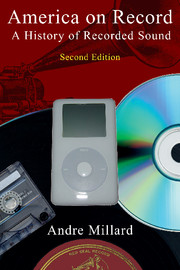Book contents
- Frontmatter
- Dedication
- Contents
- Preface to the second edition
- Preface to the first edition
- Introduction
- Part One The acoustic era
- Part Two The electrical era
- 6 The machines
- 7 Competing technologies
- 8 Empires of sound
- 9 Swing and the mass audience
- 10 High fidelity at last
- 11 Rock'n'roll and the revolution in music
- 12 The record
- 13 The studio
- 14 Perfecting studio recording
- 15 The cassette culture
- Part Three The digital era
- Abbreviations used in the notes
- Notes
- Select discography
- Select bibliography
- Subject index
- Recordings index
- Motion picture index
11 - Rock'n'roll and the revolution in music
from Part Two - The electrical era
Published online by Cambridge University Press: 05 February 2015
- Frontmatter
- Dedication
- Contents
- Preface to the second edition
- Preface to the first edition
- Introduction
- Part One The acoustic era
- Part Two The electrical era
- 6 The machines
- 7 Competing technologies
- 8 Empires of sound
- 9 Swing and the mass audience
- 10 High fidelity at last
- 11 Rock'n'roll and the revolution in music
- 12 The record
- 13 The studio
- 14 Perfecting studio recording
- 15 The cassette culture
- Part Three The digital era
- Abbreviations used in the notes
- Notes
- Select discography
- Select bibliography
- Subject index
- Recordings index
- Motion picture index
Summary
What effect did the revolution in sound have on the music that was recorded? For technological determinists, those who believe that technology is the wellspring of change, the postwar innovations appeared to have an immediate impact on the world of music. A few years after the introduction of tape-recording machines and microgroove discs, a new type of popular music burst upon the scene. Often described as a force of dramatic change in American history, the product of an enormous cultural revolution, rock'n'roll became the most influential popular music of the twentieth century. Rock'n'roll was by no means “the only revolution in the 80-year-old history of the American record industry” as some have claimed, but it made a much greater impact on American society than an earlier revolutionary form of popular music – jazz – and its effect lasted much longer. Rock as a musical style and a way of life moved effortlessly into film and television, dominating the cultural landscape for decades.
It had a dramatic new sound, an electric sound, which was characterized by the ringing tones of electric guitars amplified through loudspeakers. Electrification had not only been used in the recording process; the electric pick-up and amplifier had replaced the acoustic soundbox of the guitar with unlimited power. The sound of the crashing power chords of the electric guitar was to become the trademark of rock'n'roll.
Yet it was more than the guitar sound that made rock recordings different. There was an edge, that special reverberating echo, that can be heard in such quintessential rock'n'roll records as “Heartbreak Hotel” (Elvis Presley), “Be-Bop A Lula” (Gene Vincent), and “Summertime Blues” (Eddie Cochran). The sound of guitars and voices was changed in the recording studio to give these records a dimension different from recordings of other popular music.
It was not difficult to find a link between the revolution in sound recording and the new sound of rock'n'roll; the music came hot on the heels of the tape recorder and the microgroove disc. In fact the 7-inch, 45-rpm disc provides us with the prime artifact of rock'n'roll; much smaller and lighter than the 78, its much larger center hole created a different shape.
- Type
- Chapter
- Information
- America on RecordA History of Recorded Sound, pp. 223 - 243Publisher: Cambridge University PressPrint publication year: 2005



